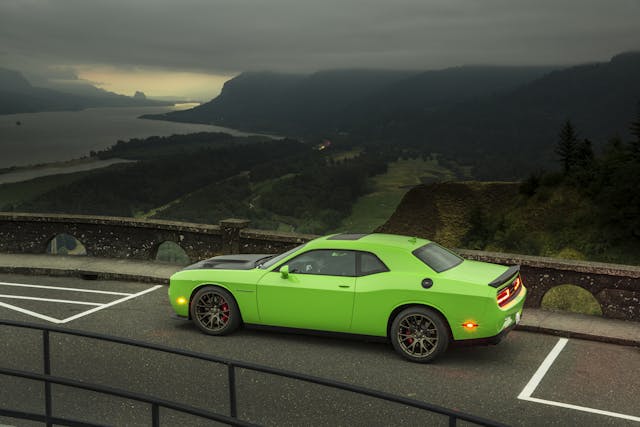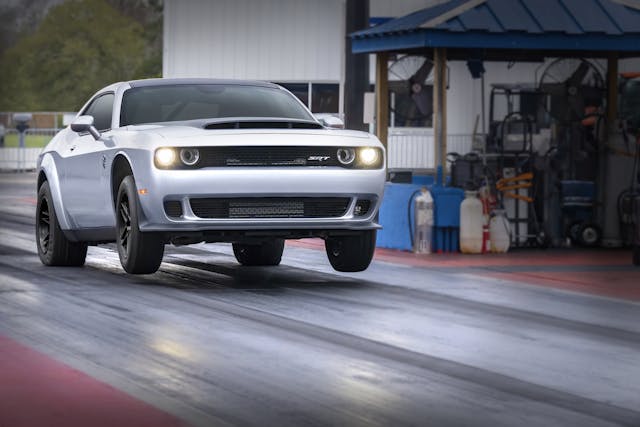Media | Articles
Infernal Interest: Dodge Challenger SRT Hellcats are slowly on the rise
Want a better understanding of what’s driving collector-car values? Sign up for the Hagerty Insider newsletter.
Like most things Hellcat-adjacent, my first memory of in-person Hellcattery is visceral. I was a summer intern at a major car rag and followed a cluster of coworkers power-walking toward the back lot, all excitedly jabbering about a new press car that just landed. The sun glinting off the then-new 2015 Dodge Challenger SRT Hellcat tester in verdant Sublime Pearl was greener than a kale smoothie. The jaded crowd was unusually effusive; 707 horsepower! Can you believe it? Will Ford respond? Will Dodge add more power?
Then, right there and then, a consensus:
These are going to be a million bucks someday.

“Someday” has yet to arrive—the only seven-figure Hellcat we’ve seen thus far is the $1.65 million charity sale of the first production example back in 2014. The Hagerty Price Guide shows most iterations of the supercharged Challenger might have further to drop before appreciation takes the reins. Yet as the Challenger and Charger Hellcats rush down the straight toward their expiration date, slated for the end of 2023, we thought it only appropriate to check in on their collectability.
Marketplace
Buy and sell classics with confidence
Let’s start with the standard O.G. “narrowbody” 2015 Challenger SRT Hellcat. That 707 hp isn’t enough to escape depreciation, with the essential Hellcat experiencing a 7.5 percent drop in value since 2018—examples in Condition #2 (Excellent) trade for an average of $54,600. However, Dodge’s continued confirmation of the Hellcat’s looming discontinuation might have turned the tide, as it’s up 10 percent since last January. The story is similar for the 2018 Challenger SRT Hellcat and the thicc-nasty 2018 Hellcat Widebody—down overall but showing a boost since 2022. Mind you, a great many used cars have appreciated in recent months amidst widespread inflation, so it’s too early to tell whether Hellcats are marching upward for good.
Things are different for the mighty and limited-production 2018 Challenger SRT Demon, the dragstrip weapon which Hagerty contributor Don Sherman called “your first tongue kiss, plunge off a diving board, and tequila shot rolled into one.” After a brief drop, it bounced right back up and today is worth 4.6 percent more than in early 2018. Said appreciation has accelerated quicker than for other Hellcats, to the tune of an 18 percent jump when compared with values in January 2022.
At the other end of the spectrum, even normally aspirated, non-Hellcat Challengers are up, albeit only marginally. The 2014 SRT8—the final model year before the major lineup-wide refresh that bequeathed the Hellcats—is up 8.3 percent since 2018 and is now worth around $36,400 average. Even the standard-issue 5.7-liter 2014 Challenger R/T has gained slightly, worth some 1.2 percent more since 2018. Here it’s particularly important to keep in mind inflation: The current $24,800 average value of a 2014 Challenger R/T has the same buying power as $20,640 in 2018.
Given the messiness of parsing inflation from appreciation, it’s perhaps more instructive to measure interest than values. Calls to our insurance center—often an expression of a model’s popularity and a leading indicator of appreciation—hint that Hellcats are on a lot of enthusiasts’ minds. Hagerty fielded 20 percent more calls about them last year than during the year prior.
What’s driving this? The obvious answer is probably the right one: The Hellcat is going away, a fact Dodge hasn’t exactly tried to keep secret. It has been hawking a series of Last Call cars—a run capped with the new 1025-hp SRT Demon 170. Those who might not be able to afford a new one or score a dealer allotment may be looking for the next best thing.

How this bodes for the Hellcat’s long-term collectability, we can only speculate. As owners of 1976 Cadillac Eldorado convertibles and 2002 Chevrolet Camaros can attest, “last of” cars don’t automatically fetch big bucks. There will almost certainly be more fast Dodges—the Charger Daytona EV concept gives us hope there—and there have been loud rumors that the next generation will also be offered with gas engines, namely the turbo “Hurricane” inline-six that is slowly but surely supplanting the Hemi V-8 across the Stellantis lineup.
And yet this really does feel like the end of something, doesn’t it? The unapologetically brash Hellcats scratch a car culture itch in a way that little else will. It’s also safe to say that there are plenty of people who lusted after but couldn’t afford Hellcats when they were new who will, as these things tend to go, make more money as they get older. The uptick in interest we’re observing right now is being led by Gen-Xers, but somewhere out there are a bunch of Gen-Zers who have worshipped Hellcats their entire childhood. (Yes, there are Gen-Zers who like cars.)
A combination of increasing demand and fixed supply is a solid recipe for appreciation. Whether or when that reaches “a million bucks” as my colleagues predicted all those years ago is anyone’s guess, but hey, it wouldn’t be the first time.

***
Check out the Hagerty Media homepage so you don’t miss a single story, or better yet, bookmark it. To get our best stories delivered right to your inbox, subscribe to our newsletters.
Via Hagerty Insider














